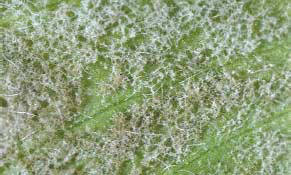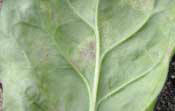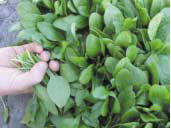|
New Races
of mildew in
spinach
Grower
Solutions Magazine
Lefroy
Valley Magazine
December
2004

by Nick Laminski
Downy mildew
(Peronospora
farinose) is probably
the most
widespread and
destructive spinach disease worldwide. Like all downy mildews, this
pathogen requires cool, wet conditions for infection and disease
development.
The heavy canopy of densely planted spinach retains
moisture and creates ideal conditions for infection and disease
development.

Fungal mycelium on
underside of spinach leaf
Spores (called sporangia) are
dispersed in the air from plant to
plant and field to field by wind and
water splash from rain and
overhead irrigation. Initial
symptoms of downy mildew
consist of bright yellow spots that
form on cotyledons and leaves.
With time, these spots can expand
and become dry. Close inspection
of the underside of the leaf often
reveals the purple to blue grey
growth of the fungus. Heavily
infected leaves appear curled and distorted and may take on a
blighted effect as a result of
numerous infection sites.
Historically downy mildew has
been controlled in the spinach
industry by planting cultivars with
single-gene resistance to a given
race. A number of crop
management practices including
the use of fungicides can control
downy mildew.
New races found
Currently there are 7 recognised
races of downy mildew.
Recently in Europe and California
new outbreaks of downy mildew
were reported on previously
resistant cultivars. Preliminary
research conducted in USA and
Europe indicated a new mildew
race, has been identified. This
new isolate reportedly infects a
wide range of new cultivars which
have resistance to races 1 to 7.
Two additional new and unique
isolates of mildew have apparantley
been identified in California.
Research underway
Research work is currently
underway to determine new
isolates compared to the known
DM races of 1 to 7. The final
naming of new isolates usually
takes approximately 18 months.
Spinach growers rely heavily on
development of varieties with
full resistance to DM races. |
World leaders in hybrid spinach,
Pop Vriend, have been actively
breeding spinach for 14 years.
Currently Pop Vriend has a number
of cultivars marketed by Lefroy
Valley in New Zealand and
Australia resistant to downy
mildew races 1 to 7. NaganoF1 is
highly resistant to races 1 - 7 and
suited for winter production.
ImolaF1 is adapted to warmer production conditions with
exceptional leaf quality and yield,
highly resistant to races 1 - 7.

Symptoms of Downy Mildew
on spinach
MonzaF1, 1 - 7 highly resistant
cultivar, has also shown good
adaptability to warm production
conditions; leaf quality and yield are
excellent.
New Zealand continues to find both Emilia and Lazio highly suitable
lines for both fresh market and
processing.
Pop Vriend are working closely with
USA and European research groups
screening existing and new lines
against downy mildew races 1 to 7
as well as evaluating how these
lines stand up to the new isolates
of downy mildew.
Pop Vriend are working closely with
USA and European research groups
screening existing and new lines
against downy mildew races 1 to 7
as well as evaluating how these
lines stand up to the new isolates
of downy mildew.
New winter trialing
New winter screening lines
SPH2211 and SPH2222, which are
highly resistant to race 1 to 7 will
be tested throughout next winter,
while SPH4131 and SPH4133 will
be evaluated for summer
production.

by Nick Laminski
Grower
Solutions Magazine
Lefroy
Valley Magazine
December
2004 |